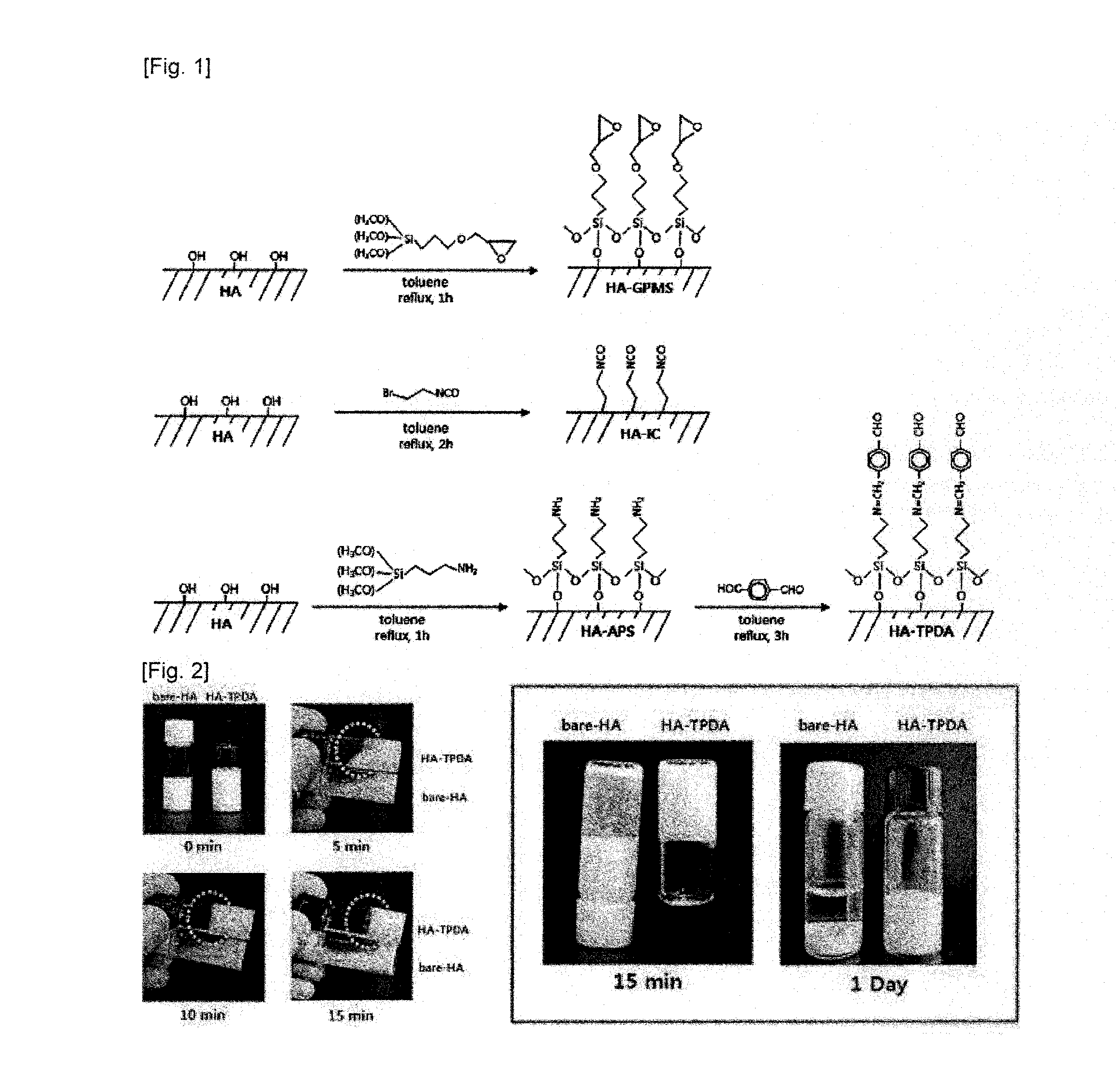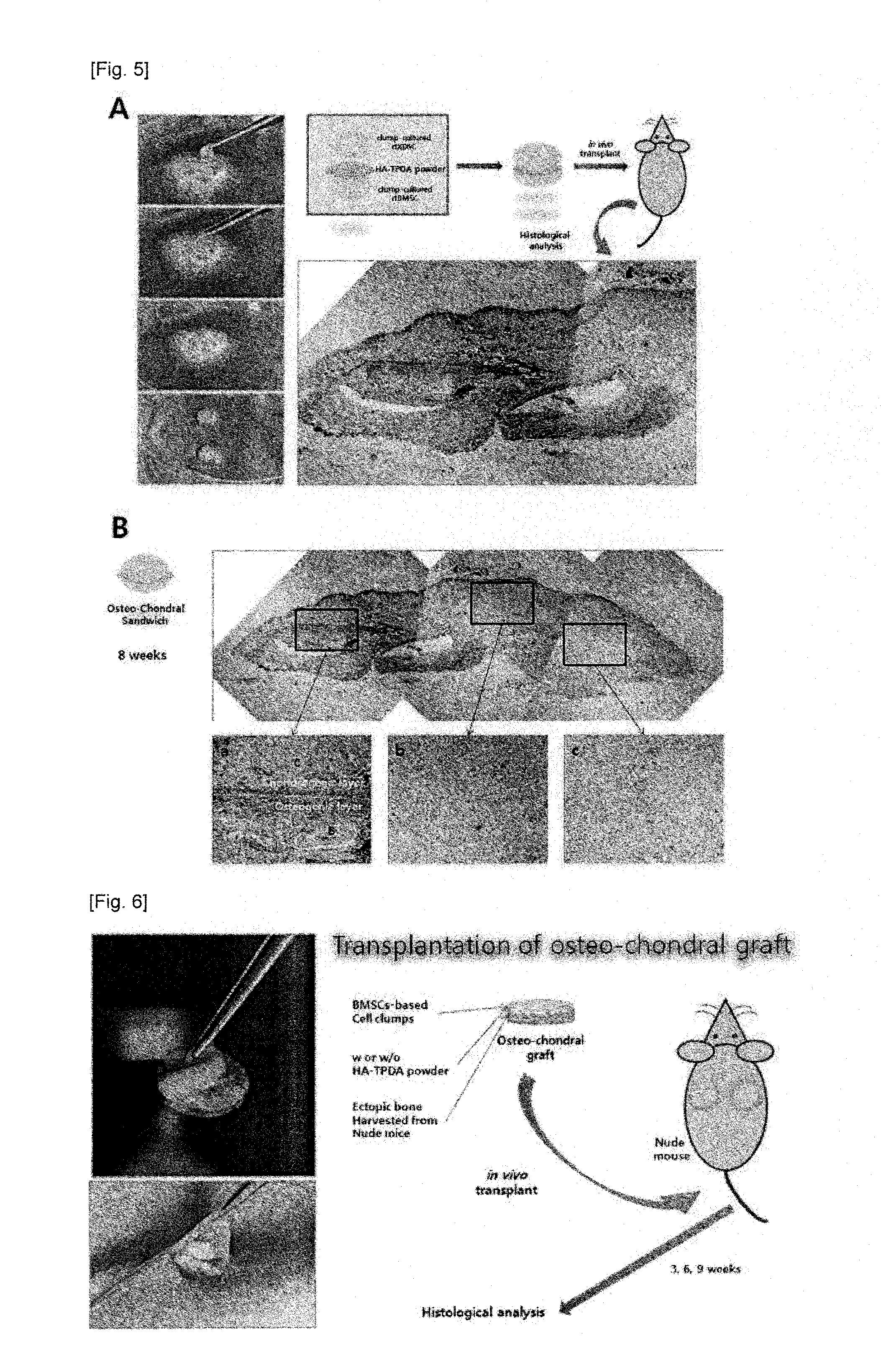Bio-adhesive agent comprising surface-modified hydroxyapatite and use thereof
a technology of hydroxyapatite and bioadhesive agent, which is applied in the preparation of isocyanic acid derivatives, group 5/15 element organic compounds, organic chemistry, etc., can solve the problems of inability to apply sutures to tissue having a structure that cannot be sutured, tissue that makes up cartilage or bone limitations, etc., and achieve excellent adhesive effect and promote bone regeneration
- Summary
- Abstract
- Description
- Claims
- Application Information
AI Technical Summary
Benefits of technology
Problems solved by technology
Method used
Image
Examples
example 1
Surface Modification of Hydroxyapatites and Confirmation
[0067]Glycidyloxypropyl trimethoxysilane (GPMS) or aminopropyltriethoxysilane (APS)-terephthaldicarboxaldehyde (TPDA) was used as a silane-based linker compound, and ethylisocyanate (EI) was used as an isocyanate-based linker compound. These linker compounds and hydroxyapatite crystal powders were added to toluene and refluxed at 110° C. for 1 hour so that the linker compounds were attached to the surface of the hydroxyapatites via a silane or isocyanate group. This procedure is shown in FIG. 1. The first one is a synthesis process of HA-GPMS, the second one is a synthesis process of HA-EI, and the third one is a synthesis process of HA-TPDA.
[0068]In order to confirm a coupling between aldehyde groups on the surface of the surface-modified hydroxyapatites and amine groups, HA-TPDA and general hydroxyapatites (bare-HA) were each mixed with an aqueous solution of chitosan. As a result, as shown in FIG. 2, in the case of HA-TPDA, ...
example 2
Confirmation of Presence of Amine Groups on the Surface of Natural Tissues
[0069]In order to achieve reaction with HA-TPDA, amine groups must be present on the surface of tissues to be attached. Whether or not amine groups are present on the surface of the subject tissues to be attached was determined as follows.
[0070]Cartilage, bone and tendon tissues were carefully isolated from a mouse so that connective tissues were not included. As shown in FIG. 3, the isolated tissues were added to 6% ninhydrin in 98% ethanol, heated at 96° C. for 10 minutes and determined on whether or not the tissues exhibit color. As a result, it was confirmed that the cartilage, bone and tendon tissues have amine groups.
example 3
In vitro Culture Experiment in Order to Confirm the Adhesive Ability of HA-TPDA
[0071]HA-TPDA powders were sprinkled on the cartilage tissues obtained from rabbit ears, and unbound HA-TPDA powders were brushed out. Multiple layers of bone marrow stromal cells (BMSCs) obtained from rats and cultured in the form of a sheet were attached to the tissues. The tissues were cultured in an alpha-MEM medium containing 20% fetal bovine serum, 1% penicillin / streptomycin, 2 mM L-glutamine, 10−8M dexamethasone and 10−4M ascorbic acid for 1 week to 3 weeks, and fixed with 4% paraformaldehyde in PBS. The fixed tissues were embedded in paraffin and cut. The degree of tissue adhered was determined by histological staining, and the results are shown in FIG. 4. As shown in FIG. 4, it was confirmed that the sheet form was remained for a longer time in the HA-TPDA-applied group than in a general hydroxyapatite-applied group.
PUM
| Property | Measurement | Unit |
|---|---|---|
| adhesion | aaaaa | aaaaa |
| structure | aaaaa | aaaaa |
| area | aaaaa | aaaaa |
Abstract
Description
Claims
Application Information
 Login to View More
Login to View More - R&D
- Intellectual Property
- Life Sciences
- Materials
- Tech Scout
- Unparalleled Data Quality
- Higher Quality Content
- 60% Fewer Hallucinations
Browse by: Latest US Patents, China's latest patents, Technical Efficacy Thesaurus, Application Domain, Technology Topic, Popular Technical Reports.
© 2025 PatSnap. All rights reserved.Legal|Privacy policy|Modern Slavery Act Transparency Statement|Sitemap|About US| Contact US: help@patsnap.com



